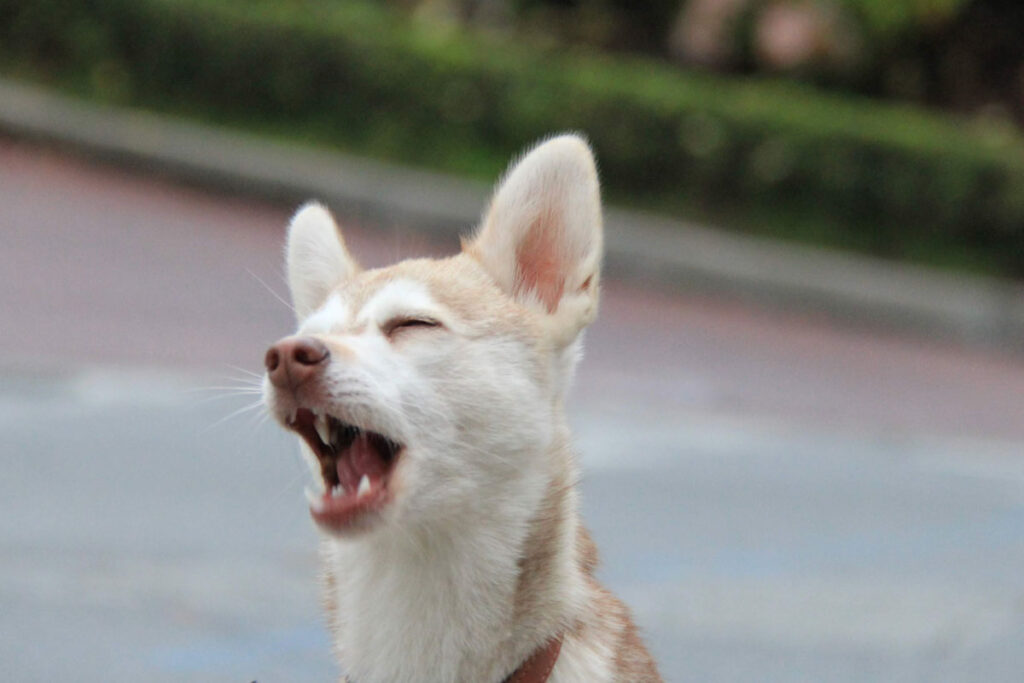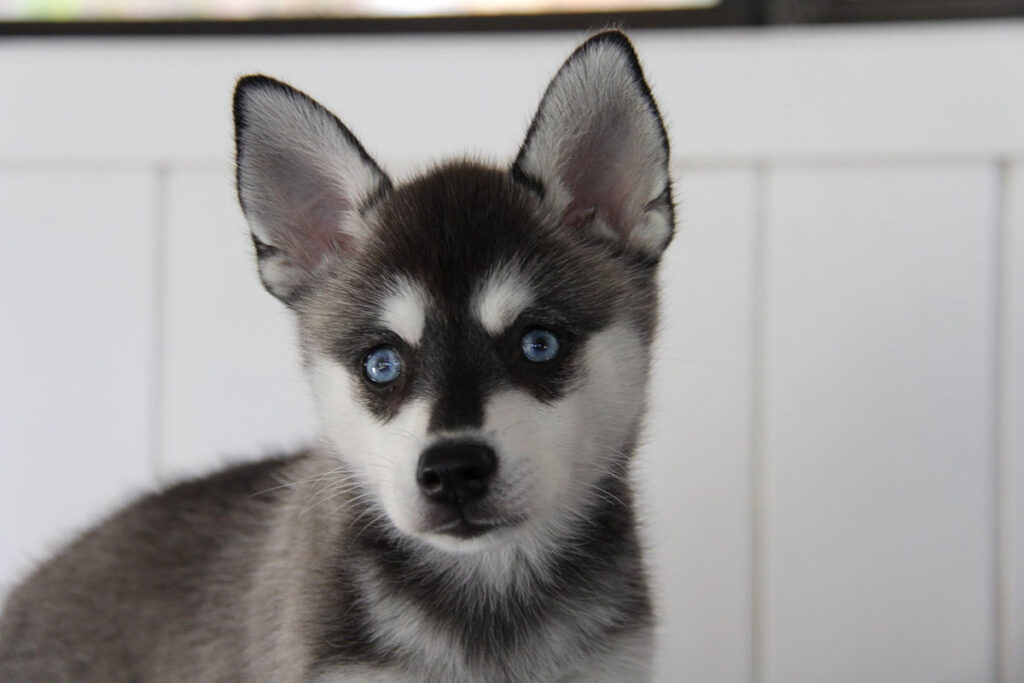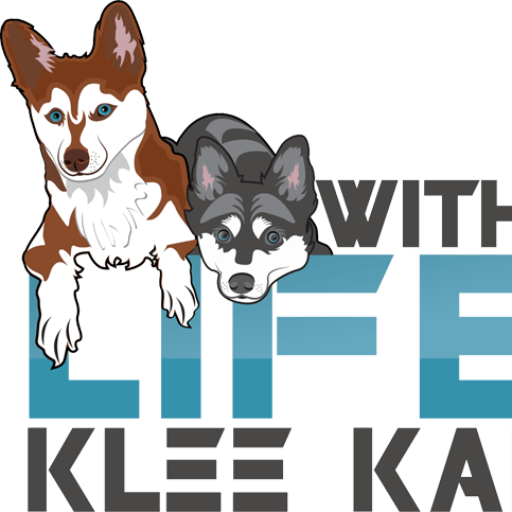
Last Updated on January 13, 2024 by Kieran Beckles
Are you looking to get a husky-like companion-sized dog – but you’re not sure whether you want an Alaskan Klee Kai or a Pomsky?
As an Alaskan Klee Kai owner, we get asked a lot if Copper and Skye are Pomskies. It’s hardly a surprise considering these two dogs effectively look like Siberian Huskies in a much smaller package.
While some dog lovers may be able to share their lives with an Alaskan Husky or Siberian Husky, you may find owning a big dog breed isn’t possible due to your life circumstances.
If you’ve decided that one of these “mini huskies” would be a better fit for your lifestyle, you may want to learn the difference between an Alaskan Klee Kai and a Pomsky to help decide between these dogs.
In this article, we’re going to take a look at the Alaskan Klee Kai and the Pomsky, sharing key differences and some of the similarities, to help shed light on these two wonderful dogs.
We’ll be sharing our insights into the Alaskan Klee Kai breed based upon our experience Copper and Skye, while social media sensation Sapphire the Pomsky have kindly sent over their input from a Pomsky perspective.
You can check out Sapphie’s website, including her book and buttons her as well as her newsletter.
Alaskan Klee Kai – Overview

The Alaskan Klee Kai breed was created by an American lady called Linda Spurlin in the 1970s.
Instead of a working dog, Spurlin wanted to create a Husky-like companion dog and used Alaskan Husky, Siberian Husky, Schipperke and American Eskimo Dog.
The Alaskan Husky shouldn’t be confused with the Alaskan Malamute or the Siberian Husky, which are two dog breeds recognized by the American Kennel Club.
Spurlin describes the Alaskan Husky as the “ancestors” of the Klee Kai.
“The Alaskan Husky is a mixture of the best, and so was the creation of the Alaskan Klee Kai. I also added a small dose of Siberian Husky, and just the right amount of smaller dogs of similar conformation for developing my original stock,” Spurlin told the Alaskan Klee Kai Association Of America.

While Spurlin didn’t initially plan to release her Alaskan Klee Kai to the public, the American eventually relented in the late 1980s.
The mixed breed was recognised as purebred dogs by the United Kennel Club in 1997 (while they’ve also been granted status by the FDC, the ARBA, CRS and the Alaskan Klee Kai Association of America).
While Spurlin first contacted the AKC in 1988, the AKK still haven’t achieved recognition by the organization at the time of writing despite featuring on their website.
Pomsky – Overview

The Pomsky is a relatively new type of mixed breed that’s often dubbed a designer breed alongside the many Doodle varities because they originated like a lot of other breeds over the past couple of decades.
Pomskies are a cross breed resulting in breeding between a Pomeranian and a Siberian Husky.
With an appearance much like mini huskies, the Pomsky has proven hugely popular because these smart dogs embody the desirable traits of Pomeranian breed and the Siberian Husky breed.
While coming in a much smaller package than Alaskan Huskies or Siberian Huskies, Pomskies have a striking appearance, a friendly temperament, lots of energy and tend to shed a lot.

The exact origins of the Pomsky aren’t clear. The American Pomsky Kennel Club state that there’s “no definitive answer to the origins” of these mixed breed dogs but suggest the first Pomsky puppies started to appear in 2012 before the so-called designer dog soared in popularity from 2014 onwards.
While the Pomsky hasn’t secured recognition by the American Kennel Club or the United Kennel Club at the current time, this could change. The APKC share their code of ethics for breeders to follow online.
The Pomsky is a relatively new and popular designer dog breed that is a cross between a Pomeranian and a Siberian Husky. This crossbreed is known for its small size, striking appearance, and friendly temperament. However, it’s essential to note that as a designer breed, Pomskies can vary in appearance and temperament.
Alaskan Klee Kai Vs Pomsky: Size

When it comes to Alaskan Klee Kai size, there are three groupings.
Standard AKK are over 15 inches up to and including 17 inches, miniature AKK are over 13 inches and up to and including 15 inches and toy AKK are up to and including 13 inches.

Pomsky can vary in size and can’t be disqualified on size despite the APKC warning about overweight members for the cross breed. Pomskies can also come in three different sizes.
Standard Pomskies are between 14 and 18 inches tall at the shoulder and should weigh between 20 and 35 pounds. Miniature Pomskies are up to 14 inches tall and weigh between 12 and 20 pounds. Toy Pomskies should be under 10 inches tall at the shoulder and can weigh up to 15 pounds.
The APKC state that a Pomsky should look like a mini husky rather than a husky-masked Pomeranian.
A key difference between these two breeds: Klee Kai are judged on height rather than weight. Pomskies appear to be measured by a combination of height and weight.
Alaskan Klee Kai Vs Pomsky: Colors

According to the United Kennel Club and the Alaskan Klee Kai Association Of America, they’ve got three permitted colors: black and white, grey and white and red and white. However, you may find Alaskan Klee Kai with white coats and some Alaskan Klee Kai who are predominantly dark colored.
Alaskan Klee Kai eyes are of medium size and can be any color or color combination, according to the breed standard. Typically, you’ll find Alaskan Klee Kai with blue or brown eyes. Some may have bi-eyes or even parti-eye.

The APKC state that Pomskies can have five permitted colors: brown, amber, green, gray or blue. Pomskies can also have bi or parti colored eyes.
The Pomsky differs from the Alaskan Klee Kai in the sense that there are many coat color variations.
The result of breeding between Pomeranians and Siberian Huskies, the APKC breed standard states that Pomskies are permitted to have any coat colors naturally occurring within either parent breed.
Alaskan Klee Kai Vs Pomsky: Appearance

Alaskan Klee Kai should have a wedged-shaped head with a distinguishing mask. Another identifying feature is an AKK’s strongly erect ears, that should be well-furred, triangular in shape.
Pomskies have a beautiful mask akin to the Siberian Husky’s facial mask, once again creating the appearance of a miniature husky. Pomskies should also have triangular, well furred ears.
Alaskan Klee Kai Vs Pomsky: Charateristics

For this section of the our feature, we’re going to share our insights into Klee Kai temperament based upon Copper and Skye, while Sheena will be discussing the personalities of Pomskies calling upon her experience with Sapphire.
Alaskan Klee Kai Temperament

Kieran & Yasmin: Copper and Skye have big personalities. The Klee Kai is effectively a smaller version of a Husky so expect big emotions, lots of talking, ample sass and lots of funny moments. At their core, Copper and Skye are affectionate, loyal, protective and loving to their family core.
Pomsky Temperament

Sheena & Sunit: Sapphie is very animated, energetic, sassy, and loving! Pomsky’s in general are a very fun breed. They will always keep you entertained whether it be vocally or through their mannerisms!
Good Pets?

Kieran & Yasmin: Alaskan Klee Kai can make great pets because they’re adaptable, energetic, smart and loyal dogs. Copper and Skye love nothing more than interacting with us as a key part of our family. They make great watch dogs and they’re apartment and city friendly.
Sheena & Sunit: They are friendly, social, and love playing with other dogs and humans. They are extremely smart and easy to train because they are very treat responsive. They can recognize our emotions, and they comfort, support, and love us unconditionally! They are very playful and active, super loyal, and will always be by your side.
Exercise
Kieran & Yasmin: Copper and Skye require lots of daily exercise and ample mental stimulation. In fact, the mental stimulation is just as important to keep their brains and senses ticking over. If you’re using to a working dog, AKK will keep you busy with the daily walks, romps inside and outside the home. The more exercise, the better!

Sheena & Sunit: Sapphie LOVES to go for walks. She goes for two long walks a day, but on weekends we take her to the park so she is able to roam around more!
Training

Kieran & Yasmin: We had different experiences with Copper and Skye. Skye is sassy, stubborn and not overly food motivated. She required more patience and repetition but is very obedient. Copper loves his food so learned quickly but he’s easily distracted with a huge prey drive.
Sheena & Sunit: We found it easy to train Sapphie mainly because she is very treat responsive. She is also very smart and picks up on things pretty quickly! I would say pomskies in general are a pretty intellectual breed.
Barking

Kieran & Yasmin: Copper and Skye make great watch dogs – we get alerted when someone is at the door whether they’re family or a delivery driver. Despite the impression given on social media, Copper only barks when you speak to him or engage him.
Sheena & Sunit: When Sapphie was younger, she used to bark quite a bit, but as she has grown older, she barely barks. She only barks when she is hungry or needs to go outside!
High Or Low Maintenance
Kieran & Yasmin: Copper and Skye are neither high or low maintenance. We see them as a little high maintenance at times because we really babied them before we had our daughter. Now that we’ve got a toddler, it’s been a transitional time for us all. However, our parents and pet sitters always describe Copper and Skye as low maintenance who just want cuddles and to nap by their side.

Sheena & Sunit: When Sapphie was younger, she was considered higher maintenance because she was an aggressive chewer and was VERY energetic. We got her sturdy toys that kept her busy and trained her daily. We are noticing as she gets older, she is becoming low maintenance. We would highly recommend training pomskies at an early age to prevent chewing and aggressive or destructive behavior!
Good First-Time Pets?
Kieran & Yasmin: Copper and Skye weren’t our first dogs but they were our first small dogs! They’ve never been destructive and we’ve had great testimonials from all our landlords. However, there are two issues we wished we had researched before we got our puppies – separation anxiety and reactivity. We’ve struggled with both problems despite working on it from a young age. Provided you’re willing to put in the effort should you encounter these problems, they’re good first-time pets. Just start when they’re puppies because it’s easier when they’re a bit smaller.

Sheena & Sunit: Honestly, Sapphie was my very first dog, and was the best decision we ever made. I really recommend training your dog as a puppy. It takes 10 minutes every day, and repetition is KEY! Because pomskies are aggressive chewers, we recommend purchasing sturdy toys to ensure that they cannot be destroyed easily. Pomskies also love to dig whether it is in the yard or on the sand at the beach, however this can be avoided by rewarding and praising them when they are obedient.
Alaskan Klee Kai Vs Pomsky: Shedding

Alaskan Klee Kai shed all year round and blow out their coat twice a year at the changing of the seasons, which isn’t a surprise seeing as their ancestors are the Alaskan Husky and Siberian Husky. They’ve got a double coat – the inner coat is dense and soft, the outer coat is coarse and straight.
The Pomsky differ from Alaskan Klee Kai, they can have four acceptable coat types – standard, plush, wooly and extra wooly. All Pomskies should be double coated with a straight and smooth outer coat alongside a dense, softer undercoat.
Grooming
Kieran & Yasmin: They’re a small version of a Husky that seems to produce just as much hair despite their sleek appearance. We brush Skye and Copper every day to keep on top of the hair (they take turns every other night).

Sheena & Sunit: Pomskies shed a lot, however they seem to shed slightly less than pure husky breeds. We groom Sapphie every 3 weeks, and we do have to vacuum our house every couple of days!
Baths

Kieran & Yasmin: Ourbreeder didn’t recommend more than a couple of baths per year. Copper and Skye don’t particularly like bath time, especially Copper. However, AKK don’t seem to have the doggie odor associated with other breeds.
Sheena & Sunit: When Pomskies are first introduced to water, they are generally very scared. The more you expose them to taking baths, the less scared and more comfortable they will become.
Alaskan Klee Kai Vs Pomsky: Health Problems

Alaskan Klee Kai do have some health concerns to consider.
The AKC write that Alaskan Klee Kai should be screened for patellar luxation, thyroid disease, heart murmur, eye disorders, and Factor VII deficiency.

Seeing as the Pomsky is a relatively new, it’s unclear the which health concerns could affect these mini huskies. However, it’s a good idea to speak to your vet for any signs of thyroid disease, dental disease and luxating patella to be extra careful.
Alaskan Klee Kai and Pomsky owners will also want to keep an eye on general health issues or common health problems such as dental disease and obesity.
We recommend the AKC’s website to learn more about health problems of the AKK and the Pomsky such as patellar luxation.
Anything Else To Consider?
The plural of Alaskan Klee Kai is in fact Alaskan Klee Kai rather than Alaskan Klee Kais. As you’ll have noted already, the plural of Pomsky is Pomskies.
If you’re thinking about either of these canines as potential pets, we recommend contacting reputable breeders to find a puppy through AKKAOA or APKC.
It’s a good idea to visit a breeder to see prospective pup and their mum, ask any questions you have. The breeder can also offer their advice on the initial weeks.
Wrapping Up

We’ve reached the end of our Alaskan Klee Kai and Pomsky comparison article.
Alaskan Klee Kai were originally bred using Alaskan Huskies, Siberian Huskies, Schipperkes and American Eskimo Dogs. The creator’s desire was to essentially create a miniature Alaskan Husky.
The Pomsky is a result of mix breeding between a Pomeranian and a Siberian Husky (Note: The Pomeranian played no part in the creation of the Alaskan Klee Kai, which is another difference between the AKK and the Pomsky).

